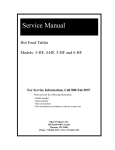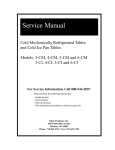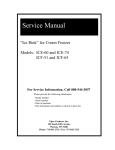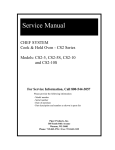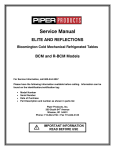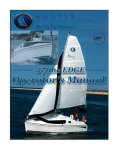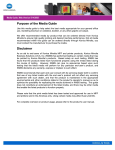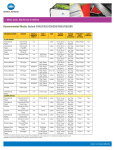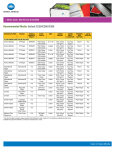Download DB Hot Food Manual
Transcript
Service Manual Design Basics Hot Food Tables Models: DB-2-HF, DB-3-HF, DB-4-HF, and DB-5-HF For Service Information, Call 800-544-3057 Please provide the following information: - Model number - Serial number - Date of purchase - Part description and number as shown in parts list Piper Products, Inc. 300 South 84th Avenue Wausau, WI 54401 Phone: 715-842-2724 / Fax: 715-842-3125 INTRODUCTION Congratulations: You have just purchased one of the finest pieces of equipment on the market today. Before installing or operating your new Piper Products, Inc. equipment, you should read through this manual. This manual should be retained for further reference as it contains installation and operating instructions, service tips, part lists and warranty information. For your safety, read and follow all cautions and warnings. Freight Damage Claims: Your Piper Products equipment was carefully inspected and packed before leaving our factory. The transportation company assumes full responsibility for safe delivery of this equipment. Piper Products cannot assume responsibilities for damage or loss incurred in transit. Visible damage or loss should be noted on the freight bill and signed by the person making the delivery. A freight claim should be filed immediately with the transportation company. If damage is unnoticed or concealed until equipment is unpacked, notify the transportation company immediately and tell them you want to file a concealed damage claim. This must be done within ten (10) days after delivery was made. Be sure to retain all packing material and cartons. WARNING Installation of this equipment should be done only by persons qualified or licensed to install electrical equipment. Adjustments and service work should be performed only by a qualified service technician. Service is available through Authorized Piper Products Parts and Service Distributors throughout the United States. For a complete listing of these call or write Piper Products, Inc. for the name of the nearest distributor. This equipment is intended for commercial use only. Not for household use. Use of other than genuine Piper Products replacement parts or service work performed by other than an authorized Piper Products service agent will void the warranty. Do not use any corrosive cleaners. Use only cleaners approved for stainless steel. INSTALLATION a. Carefully remove carton or crate from unit. Remove all loose packing materials, making sure that no small parts or accessories are lost. Inspect unit for concealed damage before discarding packing materials. b. Carefully unpack protector guard from box. Remove all loose packing materials, making sure that no small parts or accessories are lost. Inspect protector guard for concealed damage before discarding packing materials. c. It is the responsibility of the installer to comply with all local codes. d. Check unit name plate for electrical requirements. Make sure that the thermostats are all set to the "OFF" position. Connect the electrical power cord and plug to a properly sized power source of the correct voltage. e. Turn the first thermostat on the left side to the number 5 setting; pilot light will glow and the bottom of the first well on the left will start to warm. As soon as you notice heat turn the thermostat "OFF". Repeat this for each of the wells in the table. CAUTION: Bottom of well will heat rapidly and may cause sever burn if touched. Well will discolor if heated dry, do not allow well to heat more than five minutes. f. Installation is now complete. Make sure all thermostats are turned off. THEORY OF OPERATION The Hot Food Tables are designed to maintain prepared foods at a serving temperature of 140° to 160° Fahrenheit for one to two hours. The Hot Food Tables may be operated with any combination of wells dry or wet depending on the type of food being served. On tables with the optional manifold drains the entire table must be operated either wet or dry. Notice when operated dry the stainless steel well will discolor due to the high heat. Each individual well is controlled by a positive off adjustable thermostat. The thermostat knob is marked with an off position and labeled LO to HI with LO being the lowest setting and HI being the highest. These numbers do not relate to a set temperature as this will vary due to ambient conditions and different types of operation. DRY OPERATION a. Make sure that each well is empty and clean. Place a cover over each well. Turn each thermostat to the HI setting and allow wells to pre-heat for approximately 30 minutes. After 30 minutes turn thermostats back to the number 5 or 6 setting until food is placed into wells. NOTICE: Well will turn a blue-black color due to the high heat produced when operated dry. This is normal and will not harm the well. b. Uncover food wells and place pans of prepared food into the well. NEVER place food directly into food well. Temperature of food being placed into food well must be 160° Fahrenheit minimum. Turn thermostat to desired operating setting. This setting will vary according to room conditions and type of food being served. CAUTION: Never add water to a food well that has boiled dry or has been operated dry until the well has cooled. c. Always keep food pans covered when not serving, change pans of food often to insure that proper serving temperature is maintained. WET OPERATION a. IMPORTANT: Make sure that food wells are at room temperature and that each well is empty and clean. If table is equipped with optional drains be sure that drain valve is closed. b. Fill each well with HOT tap water to the water fill mark located at the end of each well. Approximately 3 /4-inch of water per well, cover each well using a tight fitting cover or food pan. c. Turn each thermostat to the HI setting and allow wells to pre-heat for approximately 45 minutes. d. Uncover food wells and place pans of prepared food into the well. NEVER place food directly into food wells. Temperature of food being placed into food well must be 160° Fahrenheit minimum. Turn thermostat to desired operating setting. This setting will vary according to room conditions and type of food being served. e. Periodically check the water level in each food well. It is very important that food wells not be allowed to boil dry. When approximately one half of the water has boiled off, hot tap water should be added to bring water level up to the fill mark. CAUTION: Never add water to a food well that has boiled dry, this will cause damage to the food well. f. Always keep food pans covered when not serving, change pans of food often to insure that proper serving temperature is maintained. g. After the serving period turn thermostats to "OFF" position and allow wells to cool before cleaning. h. Always drain or remove water from all wells after each meal. If unit is equipped with drains, place a bucket under the drain pipe and open drain valve. When bucket is full, close drain valve and empty bucket. Repeat this until all wells are drained. CAUTION: Only cleaners approved for use on stainless steel should be used. Do not use chlorinated cleaners. WET OPERATION CONT. i. Clean each well using a soft cloth or sponge with a mild detergent. Rinse completely with warm water and then dry. j. A plastic scouring pad and a mild detergent may be used to remove any hardened food or scale deposits. NOTICE: Do not use steel wool to clean wells. k. Use a soft cloth or sponge with a mild detergent to clean all exposed surfaces of the table. Rinse completely with warm water and dry. MAINTENANCE Piper equipment is constructed with the best quality materials and is designed to provide you with durable service when treated with ordinary care. To obtain the best performance from your equipment, it should be cleaned daily and maintained in good condition. CAUTION: Prior to cleaning or maintenance, turn all switches "OFF" and disconnect the power cord from the receptacle. WARNING: Do not use any chlorinated or highly caustic cleaners, acids, ammonia or other corrosive cleaners. These may cause corrosion and/or damage to the stainless steel well. Use only cleaners approved for stainless steel. Do no allow water to stand in wells for long periods of time. Water must be removed from well and the well cleaned after every serving period. Cleaning and sanitizing agents for stainless steel and aluminum should be used with a soft cloth and water. Always drain water from wells after each serving period. Stainless steel must be able to breathe and should not remain covered for long periods. PROPER OPERATION OF FOOD WELLS a. b. c. d. Add water to food wells. NEVER put over one inch of water in food well. Cover food well with cover or by placing empty food pans into wells. Turn control to the HI setting. Preheat for 45 minutes. Remove cover or food pan and immediately place pan of prepared food into food well. NEVER leave food well uncovered. Always keep a pan of food in the food well or keep it covered with a cover or empty food pan. e. Turn control to desired setting. f. To maintain proper food temperatures, keep pan of food covered when not serving. NOTE: Food wells may discolor (turn brown) if operated dry or allowed to boil dry. PROPER CLEANING OF FOOD WELLS - DAILY Food wells must be cleaned after use at least once daily. All food spillage, calcium build-up, and chlorides from the water supply must be removed. For long food well life: a. NEVER use chlorinated cleaners or other caustic cleaners. These cleaners can cause food wells to rust, pit and corrode. b. NEVER use steel wool scouring pads. The steel wool can become impregnated into the stain less steel and cause rusting or pitting. c. ALWAYS clean food wells after use with non-chlorinated cleaners. Scour with plastic scouring pad or cloth. Follow with thorough rinse and finally wipe food wells dry with soft cloth. Thorough cleaning is imperative to remove not only food spillage and calcium build-up but also chlorides, which are present in most public water supplies. NOTE: Food wells may discolor (turn brown) if run dry or allowed to boil dry. HELPFUL HINT: to minimize calcium build-up in food wells: Cream of tartar added to the water in food wells will minimize calcium build-up and aid in cleaning. At start-up add one teaspoonful of cream of tartar per gallon of water. Mix thoroughly and operate unit as previously instructed. IMPORTANT: After use or at least once daily, thoroughly clean and rinse food wells as previously instructed. CLEANING ACRYLIC PROTECTOR GUARDS WARNING: Do NOT use window cleaning sprays, kitchen scouring compounds or solvents such as acetone, gasoline, benzene or lacquer thinner. a. Use a soft cloth and mild detergent with plenty of lukewarm water to clean protector guards. b. Rinse thoroughly with lots of water and dry by blotting with a damp cloth or chamois. c. Protect and maintain the surface gloss by occasionally waxing with a good paste wax. Apply a thin even coat with a soft clean cloth and polish with cotton flannel. Wipe with a damp cloth to help eliminate electrostatic charges. d. Fine scratches can be removed by hand polishing. Apply a compound such as Simonize cleaner to a soft flannel pad and rub. When the scratches have disappeared, remove all residue and polish. SERVICE WARNING: Adjustments and service work should be performed only by a qualified service technician. For service, contact your Authorized Piper Products Inc. Parts and Service Dealer or contact Piper Products Service Department at 800-544-3057 or 715-842-2724 or fax 715-842-3125. Piper Products does not recommend that service work be performed by anyone other than a qualified service technician. If service or parts are required, contact the nearest Authorized Parts and Service Distributor. You will need to have available the complete model number, serial number, voltage and wattage, (this information is shown on the name plate attached to the control side of the unit), date of installation or purchase and a description of the problem. The Distributor must have this information in order to provide proper service or parts for your equipment. Never use chlorinated cleaners or cleaners/sanitation agents containing quaternary salts on the interior or exterior of the cooler. These cleaners can attack the stainless steel and cause rusting or pitting. Never use abrasive scouring pads. NOTE: Be especially careful with plastic parts. TROUBLESHOOTING GUIDE If problems are not found by the following checks, then you should contact your Authorized Parts and Service Distributor for service. They have the necessary parts and training to repair your unit quickly and efficiently DANGER: Disconnect all power to unit before servicing. Problem: Pilot light is off and unit does not heat. 1. Has unit been connected to proper electrical receptacles? 2. Is electric turned on at the main? Check the circuit breaker and fuse. 3. Is thermostat set to high setting? Problem: Pilot is on but unit does not heat. 1. Is thermostat set to high setting? 2. Is unit connected to proper voltage? Problem: Unit does not heat to proper temperature. 1. Is thermostat set to high or proper setting? 2. If using well with water, was hot water used to fill well? If not, allow extra time for unit to heat. 3. Has unit been allowed to pre-heat for at least 45 minutes? 4. Are there air conditioning ducts, make up air ducts or fans located near or over unit causing cool drafts? 5. Is unit connected to proper voltage? If so, is there a "low" voltage condition? TROUBLESHOOTING GUIDE Problem: Unit does not maintain food temperature. 1. Is thermostat set to high or proper setting? 2. If using well with water, was hot water used to fill well? If not, allow extra time for unit to heat. 3. Has unit been allowed to pre-heat for at least 45 minutes? 4. Were pans of food place into unit at or above 160° Fahrenheit? 5. Were food pans kept covered? Has food been kept in the unit more than two hours? 6. Are there air conditioning ducts, make up air ducts or fans located near or over unit causing cool drafts? 7. Is unit connected to proper voltage? If so, is there a "low" voltage condition? NOTE: You can check a well for the proper temperature using an electronic thermometer with a remote probe. Place the probe approximately 3/8" off the bottom and in the center of the well. Fill the well using hot tap water to the fill mark make sure that the probe covered by water. Then cover the well using a tight fitting cover or shallow food pan. Turn the thermostat to the high setting and allow unit to heat for one hour. Check the temperature, if the well is operating correctly the temperature will be 190° Fahrenheit or higher. If problems are not found by these checks then you should contact your Authorized Parts and Service Distributor or contact Piper Products Service Department at 800-544-3057 or 715-842-2724 or fax 715-842-3125 for service. PIPER PRODUCTS, INC LIMITED WARRANTY All Piper products are warranted to be free of defects in material and workmanship for a period of 12 months from date of purchase on all parts and labor. Piper Products, Inc. warrants to the original purchaser that its equipment will be free from defects in the materials and/or parts for a period of 12 months from date of shipment and reported to the factory. The purchaser is responsible for having equipment properly installed, operated under normal conditions with proper supervision and to perform periodic preventative maintenance. Equipment failure caused by inadequate water quality, improper cleaning, harsh chemicals, or acids are not covered under warranty. The manufacturer’s obligation under this warranty shall be the replacement or repair of defective parts within the warranty period. Excessive labor (more than 1/2 hour) required to access Piper equipment built into cabinets, tables or structures by others, is NOT covered under labor warranty. Example: Piper multiple- or singlewell food wells. All labor shall be performed during regular working hours. Overtime premium will be charged to buyer. After thorough examination, the decision of the Piper Products Service Department shall be final. Any defective parts to be repaired or replaced must be returned to Piper Products, Inc., 300 South 84th Avenue, Wausau, WI 54401, transportation charges prepaid, and they must be properly packed and tagged. The serial and model number of the equipment and date of original installation of such equipment must be given. However, after one year we will not assume any responsibility for any expenses (including labor) incurred in the field incidental to the repair or replacement of equipment covered by this warranty. Our obligation hereunder to repair or replace a defective part is the exclusive remedy for breach of this warranty; and we will not be liable for any other damages or claims, including consequential damages. If, upon inspection by Piper Products, Inc. or its Authorized Service Agency, it is determined that this equipment has not been properly installed or has not been used in an appropriate manner, has been modified, has not been properly maintained, the warranty will be void. Also, if the nameplate or other identifying marks have been removed, defaced or changed or the unit has been repaired or altered by persons other than expressly approved by Piper Products, Inc., the warranty will be void. If the equipment has been subjected to misuse or misapplication, neglect, abuse, accident, damage during transit or delivery, fire, flood, riot or acts of God, then this warranty shall also be void. When any situation occurs which voids the warranty the manufacturer shall not be liable for any damage to any person or any property which may result from the use of the equipment thereafter. Warranty is limited to Piper manufactured products only and does not apply to other equipment which may be connected to or installed within. No representative, dealer, distributor or any other person is authorized or permitted to make any other warranty or obligate Piper Products, Inc. to any liability not strictly in accordance with this policy. This warranty is in lieu of all other warranties expressed or implied, including any warranty of merchantability, and fitness for a particular purpose. Piper Products does hereby exclude and shall not be liable to purchaser for any consequential or incidental damages including but not limited to damages to property, damages for loss of use, loss of time, loss of profits or income, resulting from any breach of warranty.













